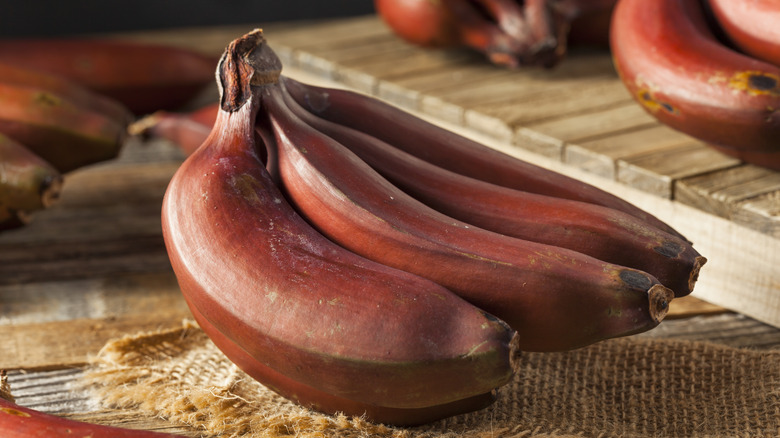Are Red Bananas Actually Different From Yellow Bananas?
There are a shocking amount of banana types grown worldwide. In fact, it's estimated that there are over 1000 varieties produced in about 150 different countries. This may come as a surprise to some, since one variety is overwhelmingly popular at American supermarkets: That's the yellow banana (aka the Cavendish), of course.
The Cavendish came to prominence after Panama disease — a destructive soil-based fungus – afflicted Gros Michel ("Big Mike") bananas in the 1950s. Until then, the latter had been by far the most popular variety. Although one of the reasons for the Cavendish's ascendance was its supposed disease resistant qualities, in recent years this variety too has proven susceptible to Panama disease, highlighting the need for more of the world's diverse banana species to be featured in supermarket produce aisles.
The red banana, for example, like the yellow, boasts a long list of health benefits, and like the yellow, it's delicious — either fresh or in a variety of prepared dishes. For those unfamiliar with the red banana, however, here's a more in-depth look at the differences and similarities between the two varieties.
What's different about red bananas
The red banana — known scientifically as Musa acuminata, and colloquially as red dacca — originated in Southeast Asia, but has since been planted in many regions around the globe. The bananas are typically shorter and fatter than the yellow Cavendish banana, and they get much of their distinctive peel color from carotenoids, naturally occurring pigments with antioxidant qualities. Anthocyanins, antioxidant pigments famous for providing color in red wine, are also found in red bananas.
The high antioxidant content of red bananas contributes to their many health benefits, per Healthline. For example, carotenoids like beta carotene and lutein promote healthy vision, while red bananas' strong antioxidant profile is thought to stave off cell damage, and lessen the likelihood of heart disease. In addition to having more antioxidants than the Cavendish, red bananas also are richer in vitamin C than their yellow brethren.
Red bananas are also quite distinct in terms of their flavor and consistency. Not only is there a raspberry flavor undertone, but ripe red bananas are also notable for their smooth, creamy fruit. And since red variety stand up to spices better than the milder Cavendish, it's easier to cook with these bananas, using them in salsas, or in the case of Thai cuisine, in curries.
How red and yellow bananas are similar
Despite their differences, red and yellow Cavendish bananas actually share many similarities. Both varieties are enjoyed fresh or in smoothies, and both are popular as a dessert ingredient. In terms of health benefits, both are excellent sources of fiber and potassium, and thus are good for our digestive systems and blood pressure, respectively, according to Healthline.
But there is one area where Cavendish bananas are clearly superior: Although red bananas are known as fast growers, Cavendish bananas not only grow fast, they produce extraordinarily high yields. They also handle extreme weather well, and continue ripening during shipping. For these reasons and more, nearly half of current worldwide banana production (47%, to be exact) is made up of Cavendish bananas, even though, as noted earlier, there are over 1,000 varieties in total.
Of course, this lack of production diversity may come with a cost — as previously stated, Cavendish bananas are currently under threat from a variant of Panama disease (aka Fusarium wilt). Thankfully there is hope, as AgFunder News reports, that new gene-edited, disease-resistant versions of Cavendish bananas will bear fruit.


